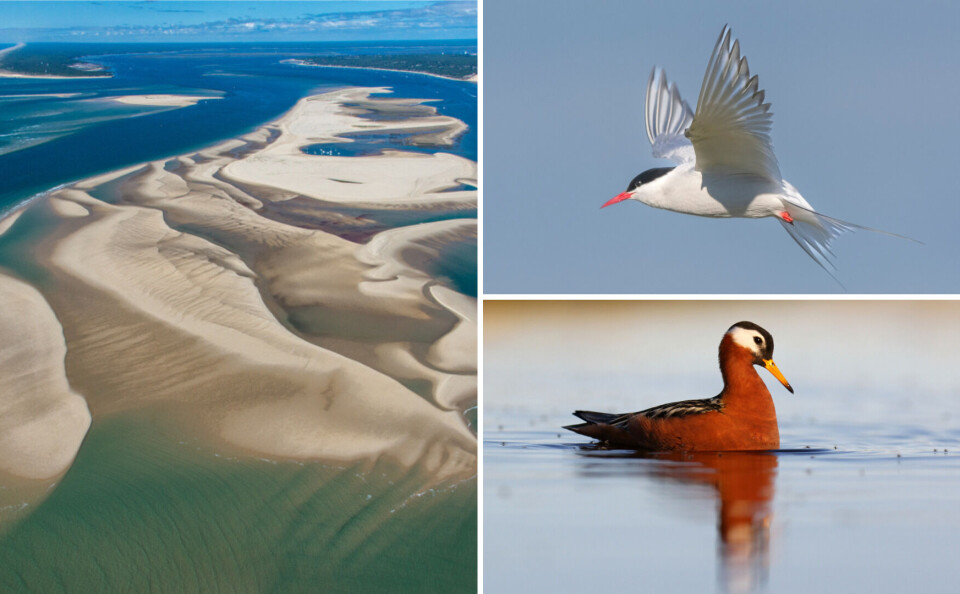-
The origins and meaning of tirer les marrons du feu
As Christmas approaches, we look at a phrase to describe someone who takes advantage of a situation
-
Step back in time for some ‘dinosaur’ planting in your French garden
Captivated in the garden this month by one species of plant that dates back 200 million years, and another which is one of the oldest flowering plant families on the planet
-
Photos: tens of thousands of migrating cranes fly across France
The birds can be seen passing from the north-east to the south-west of the country
Sea birds blown off course and into south west France by storm
Storm Domingos also caused significant damage to the Banc d'Arguin nature reserve

Rangers in a national park in south west France say Storm Domingos carried sea birds there from thousands of kilometres away.
These include migratory Arctic term and the Red phalarope, blown to shore from the Atlantic.
However, the storm also caused significant damage to the Réserve Naturelle Nationale du Banc d'Arguin nature reserve in Gironde, Nouvelle-Aquitaine, which is formed around a tidal basin.
The park covers 4,360 hectares, most of which is beach, sand dunes, sea channels and sand islands, providing a home to many native and migratory birds.
Its shifting sands channel the tide into a basin, the bassin d'Arcachon, which is well known for oyster farming.
Storm Domingos
On November 5 and 6, Storm Domingos struck the coast with winds of up to 152km/h. Fortunately, on a national level it caused less damage than storm Ciaran, which devastated many areas of Brittany and Normandy.
Read more: Worker dies and widespread damage in France from weekend storms
However, it ravaged the Banc d'Arguin. Several of its sandbanks were left obliterated or transformed, as were the oyster farms within the bay.
One of its offshore sand banks, which prior to the storm had formed a 4km-long barrier, was cut in half. Photographer Philippe Hedeline told Actu Bordeaux that the damage was heartbreaking.
“When I look at the aerial photos taken after the storm I want to cry,” he said. “Before, there was a natural barrier, and now the sea can just rush in.”
Vidéo. Après la tempête Domingos, les images de la dune du Pilat sculptée par le vent https://t.co/syQRceUELD pic.twitter.com/xDmpmTk9iI
— Sud Ouest Bordeaux (@SO_Bordeaux) November 9, 2023
While the storm caused misery for oyster farmers and fishermen, it allowed naturalists to make some surprising observations.
When the winds had settled, rangers inspecting the damage found sea birds had been blown from far across the Atlantic to the bay, including:
- Arctic terns, that migrate from the Arctic to the Antarctic and back again each year - a voyage of 22,000 km
- Common terns
- Red phalaropes, that migrate from their breeding grounds in the Arctic to South America and West Africa each year
- Leach's storm petrels, that breed on rocky islands in the Atlantic
- Barolo shearwaters, that breed in the Azores, Desertas, Savage and Canary islands.
This was not the first time that the sand banks had been destroyed in this way.
In 1981, the sand banks were almost completely destroyed by bad weather. “We could say the same thing today, but the Banc d'Arguin is still here!” the park said.
The sand banks, as a natural phenomenon, should form into a barrier for the bassin d'Arcachon once again over time.
Read more:
Birdwatcher’s guide to France: Nature reserves, parks and trails
Nature watch in France: identify doves and how to help injured birds
Aude vulture watch station: What time of day is good to visit?
























